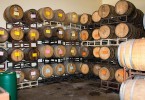Keg and bottle fermentation
Beer is one of the world’s most ancient alcoholic drinks
The definition of the word “beer” is pretty simple: it is an alcoholic drink obtained from malt (barley malt usually), hop, water and yeast. There are also other cereals that can be malted and used to produce beer: the wheat (in the German Weisse), spelt, rye, oat, millet and sorghum. In Mexico producers use also the manioc’s root or agaves or the potatoes as in Brazil. It is possible to use also non-malted cereals (for example, the wheat, in the case of the Belgian Wit Blanche). There are even some substitutes like corn and rice (Japanese beers are almost all produced with rice) but the results are not always successful.
Another important ingredient is sugar (generally brown or candied sugar) but it can be used also dextrose or other ingredients with a higher content of sugar. Honey, chestnuts, lactose, fruit and even grape must are perfect. The next phase after the mashing process is fermentation. To know better the fermentation process, how and where does it take place and what you need, we have to come back for a while and talk about the must. The main function of the mashing process is breaking amid and proteins with the help of some groups of enzymes. The process ends with the mash-out process that contributes to the conversion of the dextrin into fermentable sugars and the deactivation of amylases.

The fermentation process, how and where does it take place (bottles and keg), what does it need and what is it?
Basically, in the case of beer, the fermentation is divided in two phases: the main phase where the yeasts transform the amino acids and the must sugars into alcohol, aromatic substances and carbon dioxide. During the second phase (called ripening) the residues of yeast lay down on the bottom to balance the flavour of beer and fill it with carbon dioxide. The main phase of fermentation takes place in huge tanks; it lasts generally three or four hours and uses a yeast, the Saccharomyces cerevisiae, that requires higher temperatures to be activated. The second phase is a process that occurs in ripening tanks, it lasts four or five weeks and it needs a temperature between 0 and 2 degrees Celsius. Only some kind of beers allows a third phase called bottle fermentation that, generally increase the alcoholic volume.
Some wheat beers make an exception, in fact they maintain the same alcoholic volume in the bottle fermentation process even after the addition of yeasts. To activate the bottle fermentation it is necessary to add the yeasts before closing of the cork. Fermentable sugar can be used instead of yeast, added before the bottling. In this way, the yeasts inside the beer starts to ferment. This technique has the name of priming, if the fermentable sugars are added in the bottle or it is called bulk priming if they are blended before the bottling, directly in the fermenter. The second variable is the most advised, because is simpler and has a low margin of error.
Fermentation, how and where does it take place? Difference between high and low fermentation.

Beer makers often use the terms high, low or spontaneous fermentation. High induced fermentation beers (Ale beers) use the yeast Saccharomyces cerevisiae whereas the low induced fermentation beers (Lager beers) use yeasts that belongs to the family of the Saccharomyces Uvarum. Then there are also the spontaneous fermentation beers where the fermentation starts with the help of the yeast Brettanomyces and other bacteria in the air. The fermentation is important because it changes the flavour of the beer, its chemical composition, it becomes easy to digest, it enhances its preservation and the content of amino acids and vitamins. This contributes to the creation of acids that inhibit the proliferation of micro-organism. In other cases the fermentation is necessary to destroy and deactivate anti-nourishing factors and other toxic substances, but it isn’t our case.
Source of the Images: Wikipedia commons







